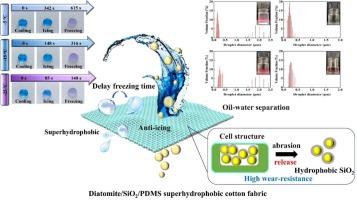用于高效油水分离和防冰的自组装细胞结构超疏水涂层
IF 7.3
2区 材料科学
Q1 CHEMISTRY, APPLIED
引用次数: 0
摘要
现有的超疏水材料用于防冰和油包水乳液分离,存在环境问题、涂层耐久性差和不可生物降解性等局限性。在这项工作中,提出了一种坚固,无氟和多功能自组装细胞结构超疏水棉织物。修饰后的纳米sio2嵌入硅藻土的空隙和孔隙中,形成独特的细胞结构。随后,用聚二甲基硅氧烷(PDMS)对浸渍硅藻土/SiO2混合物的棉织物进行疏水处理,制备出硅藻土/SiO2/PDMS组成的超疏水棉织物。制备的超疏水棉织物的水接触角(WCA)为163.6°,滑动角(SA)为4.7°,冰滞时间为615 s。此外,超疏水性棉织物对油水和油包水乳剂具有良好的分离性能。当硅藻土和PDMS被磨损或损坏时,织物表面独特的双疏水结构允许从内部释放改性的纳米二氧化硅颗粒,从而将新的粗糙度和低能量表面材料重新引入织物。因此,制备的超疏水性棉织物具有优异的耐久性和稳定性,可承受40次磨损,35次洗涤和60次冻融。本文章由计算机程序翻译,如有差异,请以英文原文为准。

Self-assembly cell structure superhydrophobic coatings for high efficient oil-water separation and anti-icing
The existing superhydrophobic materials applied in anti-icing and water-in-oil emulsion separation have some limitations, such as environmental concerns, poor coating durability and non-biodegradability. In this work, a robust, fluorine-free and versatile self-assembly cell structure superhydrophobic cotton fabric is presented. Modified nano-SiO2 was embedded into the voids and pores of diatomite, forming a unique cell structure. Subsequently, polydimethylsiloxane (PDMS) was used to hydrophobically treat the cotton fabric impregnated with the diatomite/SiO2 mixture, resulting in the preparation of superhydrophobic cotton fabric composed of diatomite/SiO2/PDMS. The resulting superhydrophobic cotton fabric demonstrates the water contact angle (WCA) of 163.6° and sliding angle (SA) of 4.7°, with an ice-delay time of 615 s. Moreover, the superhydrophobic cotton fabric demonstrates excellent separation performance for oil-water and water-in-oil emulsions. The unique dual-hydrophobic structure of the fabric surface allows for the release of modified nano-silica particles from within when the diatomite and PDMS are worn down or damaged, thereby reintroducing new roughness and low-energy surface materials to the fabric. Consequently, the prepared superhydrophobic cotton fabric exhibits outstanding durability and stability, enduring 40 cycles of abrasion, 35 cycles of washing and 60 cycles of freeze-thaw.
求助全文
通过发布文献求助,成功后即可免费获取论文全文。
去求助
来源期刊

Progress in Organic Coatings
工程技术-材料科学:膜
CiteScore
11.40
自引率
15.20%
发文量
577
审稿时长
48 days
期刊介绍:
The aim of this international journal is to analyse and publicise the progress and current state of knowledge in the field of organic coatings and related materials. The Editors and the Editorial Board members will solicit both review and research papers from academic and industrial scientists who are actively engaged in research and development or, in the case of review papers, have extensive experience in the subject to be reviewed. Unsolicited manuscripts will be accepted if they meet the journal''s requirements. The journal publishes papers dealing with such subjects as:
• Chemical, physical and technological properties of organic coatings and related materials
• Problems and methods of preparation, manufacture and application of these materials
• Performance, testing and analysis.
 求助内容:
求助内容: 应助结果提醒方式:
应助结果提醒方式:


